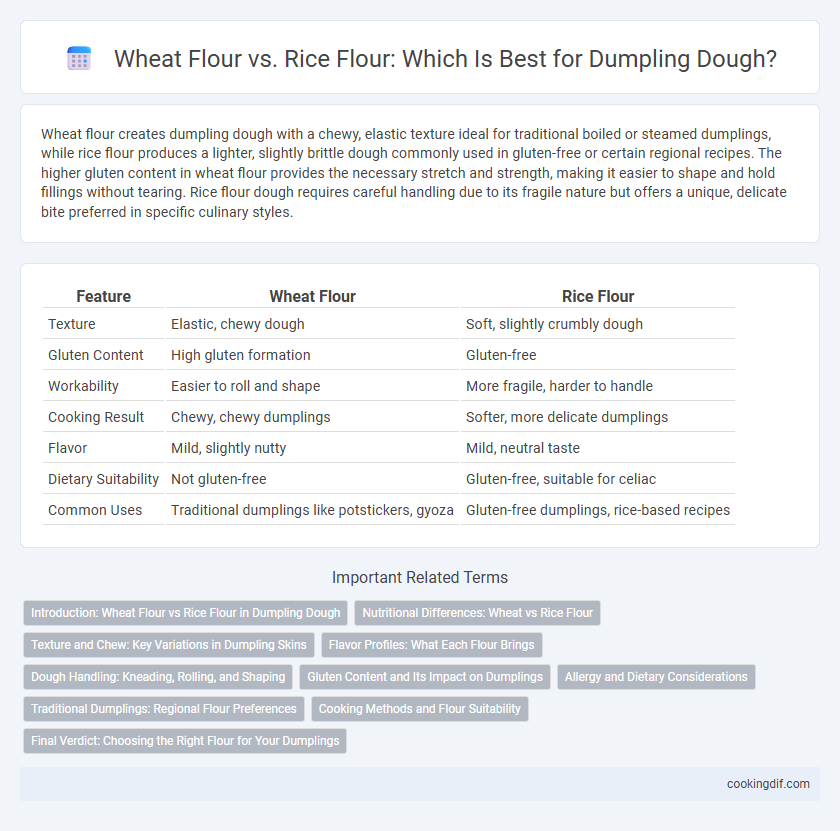Wheat flour creates dumpling dough with a chewy, elastic texture ideal for traditional boiled or steamed dumplings, while rice flour produces a lighter, slightly brittle dough commonly used in gluten-free or certain regional recipes. The higher gluten content in wheat flour provides the necessary stretch and strength, making it easier to shape and hold fillings without tearing. Rice flour dough requires careful handling due to its fragile nature but offers a unique, delicate bite preferred in specific culinary styles.
Table of Comparison
| Feature | Wheat Flour | Rice Flour |
|---|---|---|
| Texture | Elastic, chewy dough | Soft, slightly crumbly dough |
| Gluten Content | High gluten formation | Gluten-free |
| Workability | Easier to roll and shape | More fragile, harder to handle |
| Cooking Result | Chewy, chewy dumplings | Softer, more delicate dumplings |
| Flavor | Mild, slightly nutty | Mild, neutral taste |
| Dietary Suitability | Not gluten-free | Gluten-free, suitable for celiac |
| Common Uses | Traditional dumplings like potstickers, gyoza | Gluten-free dumplings, rice-based recipes |
Introduction: Wheat Flour vs Rice Flour in Dumpling Dough
Wheat flour is the traditional choice for dumpling dough due to its high gluten content, which provides elasticity and a chewy texture ideal for wrapping fillings. Rice flour, lacking gluten, results in a more delicate and brittle dough that is typically used for gluten-free or steamed dumplings with a softer bite. Understanding the differences in texture and elasticity between wheat and rice flour is essential for achieving the desired dumpling consistency and culinary outcome.
Nutritional Differences: Wheat vs Rice Flour
Wheat flour contains higher protein and gluten, providing elasticity essential for chewy dumpling dough, while rice flour is gluten-free and often used for lighter, crispier textures. Nutritionally, wheat flour offers more fiber, B vitamins, and minerals like iron, supporting digestion and energy metabolism. Rice flour is lower in protein but easier to digest and suitable for gluten-intolerant individuals, making it a healthier alternative in specific dietary needs.
Texture and Chew: Key Variations in Dumpling Skins
Wheat flour dumpling dough offers a chewy and elastic texture due to its higher gluten content, resulting in pliable and robust skins ideal for steaming and boiling. Rice flour creates a lighter, more delicate dumpling skin with a slightly grainy texture, favored in gluten-free recipes but often less stretchy and more prone to tearing. The choice between wheat and rice flour significantly impacts the dumpling's mouthfeel, with wheat flour enhancing chewiness and rice flour delivering a tender bite.
Flavor Profiles: What Each Flour Brings
Wheat flour imparts a slightly nutty and robust flavor to dumpling dough, creating a chewy texture that enhances savory fillings. Rice flour offers a lighter, subtly sweet taste with a smoother, delicate texture ideal for steamed or pan-fried dumplings. Choosing between wheat and rice flour influences both the flavor intensity and mouthfeel, directly shaping the overall dumpling experience.
Dough Handling: Kneading, Rolling, and Shaping
Wheat flour dough for dumplings offers elasticity and strength, making kneading smooth and allowing easy rolling into thin, uniform wrappers. In contrast, rice flour dough tends to be more fragile and dry, requiring gentle handling to prevent cracking during shaping. Proper hydration and resting time enhance the pliability of rice flour dough, allowing successful molding without tearing.
Gluten Content and Its Impact on Dumplings
Wheat flour contains high levels of gluten, which provides elasticity and chewiness to dumpling dough, resulting in a more pliable wrapper that holds fillings securely. Rice flour, being gluten-free, produces a softer and more delicate texture but lacks the stretchiness needed for traditional dumpling shapes, often leading to more brittle skins. The gluten content in wheat flour is critical for dough cohesion and elasticity, directly affecting the dumpling's structural integrity and mouthfeel.
Allergy and Dietary Considerations
Wheat flour dumpling dough contains gluten, which can trigger allergic reactions or celiac disease in sensitive individuals, making it unsuitable for those with gluten intolerance. Rice flour offers a gluten-free alternative, reducing the risk of allergic responses and catering to gluten-sensitive or celiac patients. Choosing between wheat and rice flour is crucial for accommodating dietary restrictions and ensuring safe consumption for people with specific allergies.
Traditional Dumplings: Regional Flour Preferences
Traditional dumplings exhibit distinct regional preferences for wheat flour and rice flour based on texture and flavor profiles. Northern Chinese dumplings predominantly use wheat flour for its gluten content, providing elasticity and chewiness essential to classic jiaozi dough. Conversely, southern regions favor rice flour in specific dumpling varieties like zongzi or tangyuan, prized for their delicate, soft, and slightly sticky texture.
Cooking Methods and Flour Suitability
Wheat flour's higher gluten content creates a stretchy dough ideal for boiling or steaming dumplings, maintaining structure and chewy texture. Rice flour, lacking gluten, produces a more delicate and tender dough perfect for frying or pan-frying, resulting in a crispy exterior. Choosing the right flour depends on the cooking method to balance texture and dough durability in dumplings.
Final Verdict: Choosing the Right Flour for Your Dumplings
Wheat flour creates dumpling dough with a chewy, elastic texture ideal for traditional dumplings, thanks to its higher gluten content. Rice flour produces a tender, softer dough with a slightly grainy texture, often preferred for gluten-free or lighter dumplings like steamed varieties. Choosing between wheat and rice flour depends on desired texture and dietary needs, with wheat flour best for classic elasticity and rice flour suitable for gluten intolerance and delicate finishes.
Wheat flour vs rice flour for dumpling dough Infographic

 cookingdif.com
cookingdif.com